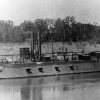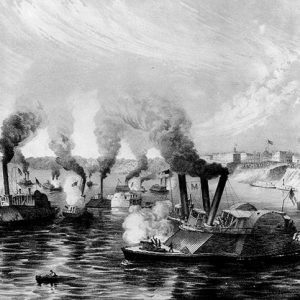calsfoundation@cals.org
CSS General Sterling Price
aka: CSS General Price
aka: CSS Price
aka: Laurent Millaudon
aka: L. Millandon
aka: Milledon
The CSS General Sterling Price was a Confederate ram that saw combat on the Mississippi River before being sunk during the 1862 Battle of Memphis, after which it served the rest of the Civil War as a Union warship.
The Confederate War Department purchased fourteen boats in 1862 with the intent of converting them into warships in the Mississippi River Defense Fleet under the command of Captain James E. Montgomery. One of them was the Laurent Millaudon, a 483-ton sidewheel towboat built in 1856 in Cincinnati, Ohio, for the Good Intent Towboat Company and commanded by Capt. W. S. Whann. The Confederates renamed it the General Sterling Price after the Missouri State Guard general who led troops in extensive action in Arkansas and the Trans-Mississippi Theater. The CSS General Sterling Price was 182 feet long, thirty feet wide, and nine feet three inches deep.
Conversion of the steamboat into a ram began in New Orleans, Louisiana, on January 25, 1862, with the addition of a sheathing of four-inch-thick oak planks and inch-thick iron coating on its bow. In addition, compressed cotton bales were placed behind double pine bulkheads to provide extra protection. The Price, under the command of Captain J. H. Townsend, left New Orleans on March 25, heading to Memphis, Tennessee, for final alterations.
The Price’s conversion to a warship was finished by April 11, and the ram was sent up the Mississippi to help defend Memphis from the Federal Mississippi Flotilla. The General Sterling Price was among seven Confederate vessels that confronted the Union fleet at Plum Point Bend near Osceola (Mississippi County) on May 10, 1862. The Price, then commanded by First Officer J. E. Henthorne, was among three rams that attacked the USS Cincinnati, which was protecting Mortar Boat No. 16 as it shelled the Confederate works at Fort Pillow on the Tennessee side of the river. The General Bragg hit the Cincinnati’s starboard side, after which the Sumter and Price rammed the stricken Union gunboat, the Price tearing off the Cincinnati’s rudder and part of its stern. The Federal gunboat sank in shallow water. The Price, having sustained heavy damage from Union cannon fire, soon withdrew with the rest of the Confederate fleet, unable to pursue the lighter Union gunboats into shallower water.
The River Defense Fleet and General Sterling Price were back on the waters at Plum Point Bend in early June, holding off the Federal flotilla as Confederate forces abandoned Fort Pillow, after which the fleet fell back to Memphis to refuel.
On June 6, 1862, Flag Officer Charles H. Davis led the U.S. Mississippi Flotilla to Memphis, where Confederate commander Montgomery, his boats still low on fuel, swung out to engage them. It was a disaster for the Rebel fleet, as every one of its vessels was either destroyed or captured—only the General Earl Van Dorn escaped to the south because of its superior speed. During the action, the CSS General Sterling Price, along with the CSS General Beauregard, targeted the Union ram USS Monarch. However, the Beauregard missed the Federal boat and instead struck the Price on its port side. The damaged Price, also attacked by the Union ram USS Queen of the West, sank on a sandbar on the Arkansas shore.
Federal troops raised the sunken ram, and on June 16, 1862, it was brought into Union service as the USS General Price, commanded by Lieutenant LeRoy Fitch. It was sent to Cairo, Illinois, for repairs, which were completed by March 11, 1863. The Price participated in the failed attempt to flank the Confederate stronghold at Vicksburg, Mississippi, via Steele’s Bayou, which ended on March 22, and then ran a gantlet of Southern cannon fire on April 17 to take up position south of the Confederate bulwark.
The Price ferried troops and escorted transports during operations against Grand Gulf, Mississippi, in late April and early May, after which it helped capture Alexandria, Louisiana, and exchanged fire with Confederate batteries at Harrisonburg, Louisiana, on the Black River before taking part in the final operations against Vicksburg, which surrendered on July 4, 1863.
The Price then steamed to Cairo, where repairs were completed by November 19, 1863, then sailed to Memphis to join Admiral David Porter’s fleet and participate in the 1864 Red River Campaign. In March 1864, the former Confederate vessel accidentally rammed the USS Conestoga, sinking the Union gunboat. During the campaign, the General Price escorted troop transports, afterward cruising the lower Mississippi River to protect Federal troops and combat Rebel guerrillas. On May 19, 1864, the Price fought a Confederate battery at Tunic Bend, Louisiana, then landed troops ashore who burned a Rebel headquarters. The ram patrolled the Mississippi between New Orleans and Donaldsonville, Louisiana, for the rest of the war. The USS General Price was decommissioned at Mound City, Illinois, on July 24, 1865, and sold to W. H. Harrison on October 3, 1866. Its fate after that is unknown.
For additional information:
“General Sterling Price.” Dictionary of American Fighting Ships. www.hazegray.org/danfs/csn/g.txt (accessed May 25, 2022).
“General Sterling Price.” Dictionary of American Fighting Ships. www.hazegray.org/danfs/iron/g_sprice.txt (accessed May 25, 2022).
McCaul, Edward B., Jr. To Retain Command of the Mississippi: The Civil War Naval Campaign for Memphis. Knoxville: University of Tennessee Press, 2014.
“River Defense Fleet.” Dictionary of American Fighting Ships. www.hazegray.org/danfs/csn/annex_2.txt (accessed May 25, 2022).
Tomblin, Barbara Brooks. The Civil War on the Mississippi: Union Sailors, Gunboat Captains, and the Campaign to Control the River. Lexington: University Press of Kentucky, 2016.
Way, Frederick Jr., comp. Way’s Packet Directory, Athens: University of Ohio Press, 1983.
Mark K. Christ
Central Arkansas Library System
 Civil War through Reconstruction, 1861 through 1874
Civil War through Reconstruction, 1861 through 1874 Military
Military Steamboats (Civil War)
Steamboats (Civil War) Destruction of Rebel Fleet
Destruction of Rebel Fleet 




Comments
No comments on this entry yet.